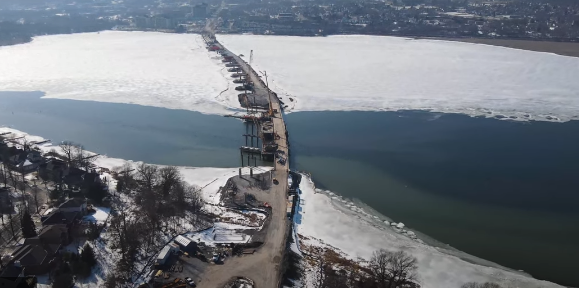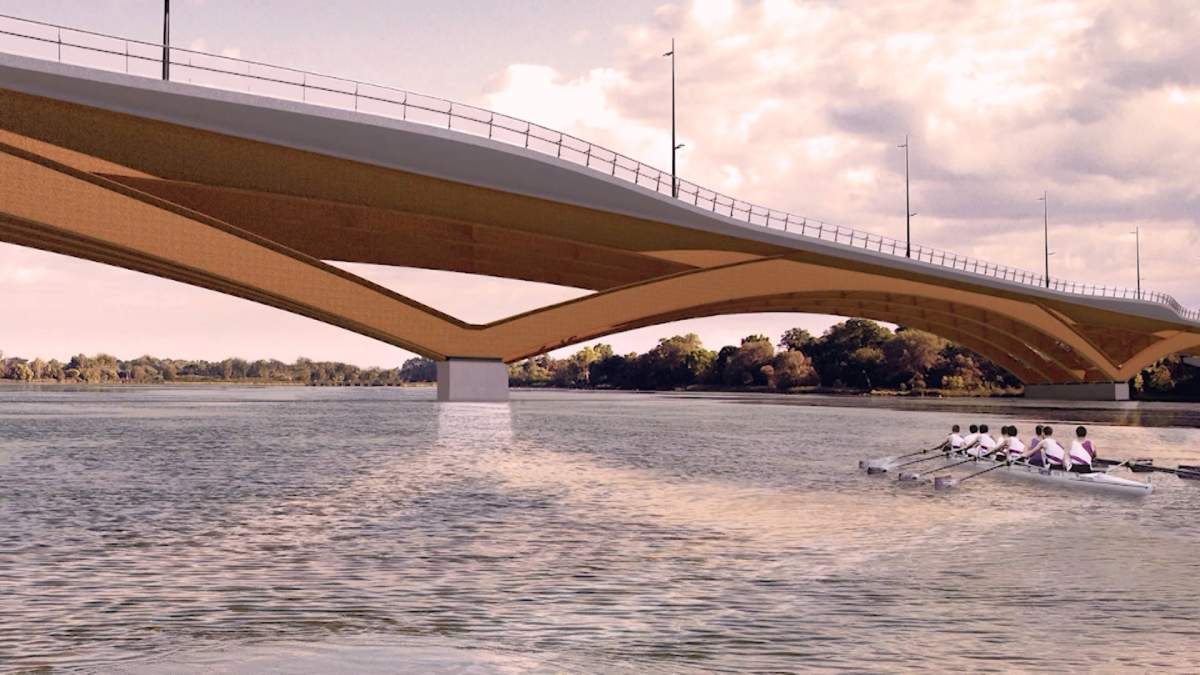While the dreaded third wave of the COVID-19 pandemic and its fast-spreading variants grab most of the headlines, work on Kingston’s largest infrastructure project continues to progress swiftly and quietly under the radar.

Construction of a $180-million bridge over the Cataraqui River is now 50-per cent complete, and remains on track for “substantial completion” by the end of 2022, according to the latest Third Crossing bridge progress report to council March 23.
“With the underwater construction activities largely completed, the above water form of the bridge is becoming more visible as work progresses on several of the bridge components,” said a report from Peter Huigenbos, the city’s commissioner of business, environment and projects.
Staff reported that on-site construction work progressed steadily through the first quarter of 2021, reaching a significant milestone in late February with the completion of all the bridge foundations and piers.
Nearly two dozen foundations were placed on the bedrock below the riverbed that will support the massive concrete and steel beams above water.
“This concludes a critical phase of the overall bridge construction work that started in mid-2020,” Huigenbos noted.
Another visible sign of progress is the massive bridge decking and support beams that are being trucked into the city every week.
The installation of concrete girders commenced in early February.
A total of 95 reinforced concrete girders, manufactured by DECAST at their plant near Barrie, Ont., will support the bridge deck.
“Each girder measures over 150 feet in length and weighs over 180,000 pounds making them some of the longest and heaviest girders ever built for a transportation infrastructure project in Ontario,” the report stated.

Get daily National news
Crews are installing four girders per week and should have 24 installed by late March.

The team has also constructed a temporary lift bridge at the navigation channel of the Rideau Canal to keep boat traffic moving during the three-year in-water construction project.
Supported by $60 million in equal funding from all three levels of government, the bridge will feature two lanes for motorized vehicles and a dedicated four-metre wide multi-use pathway on the south side of the bridge.
City officials say more than $92 million — about 50 per cent — of the bridge bucks have been spent, suggesting it continues to track on budget despite some challenges posed by the pandemic such as enhanced on-site health and safety measures for workers, physical distancing and the need for worksite cleaning and disinfection.
Project leaders also boasted about the massive project’s impact on the Kingston-area, including:
- Over $7.2 million spent on locally sourced material and contracts
- Over 31,000 hours of local labour secured from less than 40 kilometres away from Kingston
- 68 contracts have been secured with local businesses
- 56 community service hours have been offered by contractors
They say another risk factor is closely monitoring the supply chain to ensure there are no future construction material delays.
To keep the project humming along, the construction consortium that was awarded the 1.1-km-long bridge contract applied to Fisheries and Oceans Canada for an exemption from the in-water work exclusion period from March 15 to July 1, a period of aquatic spawning and other wildlife nesting.
The team persuaded the federal department to approve the exemption based on environmental protection measures and proposed monitoring.
While in-water work is moving full-speed ahead, final intersection designs for the bridge landing points at Gore Road and Highway 15 on the eastern shore, and Montreal Street and John Counter Boulevard on the western shore, are also progressing.
“All of the main design packages for the bridge and roadworks have now been issued for construction,” the report stated.
The city also says it has been communicating its progress regularly with residential neighbours on both sides of the river, along with providing updates on extended construction hours.
Another key component of the new bridge is giving it a name.
Kingston city council decided the Third Crossing naming will be done “in a way that reflects and celebrates the stories and contributions of Indigenous communities in this region, both past and present.”
The city says consultation for the bridge naming is being facilitated with the support of First People’s Group and will involve discussions with Alderville First Nation and Tyendinaga Mohawk Council, Indigenous Nations with historical ties to the area, as well as with interested members of the local Indigenous community.
“This will be followed by a broader consultation with Kingston residents around proposed names and their meanings.”
Potential names will be discussed over the summer months with a naming recommendation expected to go to council for final approval in November or December of this year.
The aptly-named Third Crossing is situated about midway between the city’s two existing transportation routes, Highway 401 and the LaSalle Causeway.








Comments